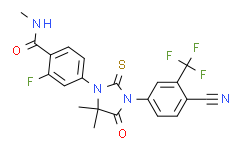| Cas No.: | 915087-33-1 |
| Chemical Name: | Enzalutamide(MDV-3100) |
| Synonyms: | Enzalutamide(MDV-3100);[14C]-Enzalutamide;N-methyl-4-[3-(4-cyano-3-trifluoromethylphenyl)-5,5-dimethyl-4-oxo-2-thioxoimidazolidin-1-yl]-2-fluorobenzamide;4-(3-(4-cyano-3-(trifluoromethyl)phenyl)-5,5-dimethyl-4-oxo-2-thioxoimidazolidin-1-yl)-2-fluoro-N-methylbenzamide;Enzalutamide;MDV 3100;4-[3-[4-cyano-3-(trifluoromethyl)phenyl]-5,5-dimethyl-4-oxo-2-sulfanylideneimidazolidin-1-yl]-2-fluoro-N-methylbenzamide;Enzalutamide (MDV3100);Enzalutamide(MDV3100,Xtandi®);MDV-3100;UNII-93T0T9GKNU;XTANDI |
| SMILES: | S=C(N(C(C1(C)C)=O)C2=CC=C(C#N)C(C(F)(F)F)=C2)N1C3=CC(F)=C(C(NC)=O)C=C3 |
| Formula: | C21H16F4N4O2S |
| M.Wt: | 464.4359528 |
| Sotrage: | 2 years -20°C Powder, 2 weeks 4°C in DMSO, 6 months -80°C in DMSO |
| Description: | Enzalutamide (MDV3100) is an androgen receptor (AR) antagonist with an IC50 of 36 nM in LNCaP prostate cells. |
| In Vivo: | Enzalutamide has greater affinity to AR than Bicalutamide does in a competition assay with 16β-[18F]fluoro-5α-DHT (18-FDHT) in castration-resistant LNCaP/AR cells (AR-overexpressing). While Enzalutamide shows no agonism in LNCaP/AR prostate cells. Enzalutamide antagonizes induction of prostate-specific antigen (PSA) and transmembrane serine protease 2 (TMPRSS2), combination with the synthetic androgen R1881 in parental LNCaP cells. Enzalutamide inhibits the transcriptional activity of a mutant AR protein (W741C, mutation of Trp741 to Cys)[1]. Enzalutamide also prevents nuclear translocation and co-activator recruitment of the ligand-receptor complex[2]. |
| In Vitro: | Enzalutamide has greater affinity to AR than Bicalutamide does in a competition assay with 16β-[18F]fluoro-5α-DHT (18-FDHT) in castration-resistant LNCaP/AR cells (AR-overexpressing). While Enzalutamide shows no agonism in LNCaP/AR prostate cells. Enzalutamide antagonizes induction of prostate-specific antigen (PSA) and transmembrane serine protease 2 (TMPRSS2), combination with the synthetic androgen R1881 in parental LNCaP cells. Enzalutamide inhibits the transcriptional activity of a mutant AR protein (W741C, mutation of Trp741 to Cys)[1]. Enzalutamide also prevents nuclear translocation and co-activator recruitment of the ligand-receptor complex[2]. |






















